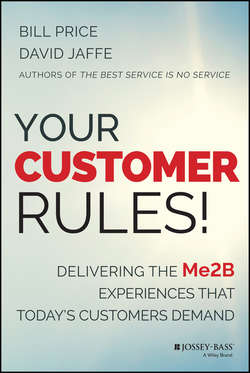Читать книгу Your Customer Rules! - Bill Price - Страница 8
На сайте Литреса книга снята с продажи.
Chapter One
From B2C to Me2B
Welcome to the Me2B World: Now Your Customer Rules!
ОглавлениеUnsatisfying, clunky customer service experiences pose an even more serious threat to businesses' survival than they would have ten years ago. Today's customers have significantly more power. The Internet, social media, mobile access, and all the other recent dynamic changes have moved us far beyond the command-and-control era, when organizations could tell their customers what was best for them – while really aiming to increase short-term profits.
For many years, people have largely categorized businesses in two models, B2B and B2C. B2B organizations sell to other businesses; B2C organizations sell to mass-market consumers. (There's also the more complicated third model, B2B2C, where an intermediate business such as a reseller or broker sells to the consumer.) These models suggest that the business controls and directs the relationship: They go to the other business, or to the consumer. They hold the power and direct the relationship.
Meanwhile, in the past decades, we've seen these sweeping global changes:
1. Social networks via the Internet have forever changed the way organizations operate. Customers, whether individuals or businesses, have access to limitless information about competing goods and services. And for the first time customers now have the opportunity to influence thousands, or even millions, of other customers; they are helping each other, often trusting their peers instead of the companies themselves. We call this C2C communication.
2. We have entered the mobile age, where information travels with us and is at our fingertips. Customers can be anywhere and access Internet-sourced information, impacting decisions straight up to the point of sale.
3. Internet-enabled transactions, the cloud, Big Data, and other technologies are transforming business models. Whole industries are being disrupted, in many cases significantly lowering the barrier to entry. The handful of upstart companies that have created new ways to operate and are successfully delivering scaled, personalized omni-channel customer experience have raised the bar for legacy businesses saddled with old and expensive ways to operate.
4. The powerful Millennial generation is emerging as a customer base and has vastly different expectations of the buying experience. This generation has been raised on Amazon and Apple, as well as on the flexibility and power of rapidly growing C2C peer-to-peer sharing networks such as AirBnb, Uber, and Facebook. When they do act as consumers, they have higher standards for customer experience than their older siblings or parents and are less patient – and more willing to switch fast if treated marginally. That said, they are willing to remain brand or service loyal if treated well.8
All these trends add up to a new reality: Customers, not businesses, hold the power. The only business model today, therefore, is not B2C or B2B but Me2B. Customers own the relationships and determine how they want to interact with the business. Businesses must shift their thinking to drive decision making from the consumer's point of view. Repeat after us: Me2B because the customer rules!
There are some major implications of this reversal, threatening to some organizations but exhilarating and business defining to others.
● Customers have significantly greater choice. There is now so much information out there for consumers – online and offline, from their homes or when walking past stores – that this choice is now much wider than any one provider or company.
● Customer feedback, wants, and desires are broadcast loud and clear. No longer do organizations have to conduct outbound consumer tastes surveys, mall intercepts asking customers to answer questions while strolling around shopping centers, or other forms of expensive research. Customers are using a plethora of electronic mechanisms to tell their friends actively what they like and dislike, and to tell organizations what they think about them.
● Companies can no longer hide poor products or service. Third-party customer feedback sites encourage open postings and comments on others' experiences, and general social sites have proliferated as well. Any customer who encounters poor service can tell thousands of people in seconds, and since customers tend to trust other customers, even those they do not know, more than the companies themselves, the viral effect is amazing!9 YouTube views (and likes or dislikes) and other video options intensify these customer reactions, to the peril of organizations asleep at the wheel or in denial about their product or service performance.
● Pricing is transparent without leaving home or having to visit multiple stores. From their smart phones or tablets, thanks to comparison engines, customers know more about their choices than many sales clerks or product managers. Moreover, customers rebel when they encounter variable pricing by time of day or by customer segment. They seek the lowest possible price and have bots and applications to tell them when their desired flight is cheaper or when they win a bid for a hotel stay at their preferred price.
This much more is clear: Businesses that fail to find ways to satisfy customer needs at scale – using all of today's channels and providing the sort of experiences we remember from the mom-and-pop days – will not survive.
8
Marketing Charts. 2014. “Millennials and Brand-Marketing: A Complicated Affair.” March 25. Accessed May 17, 2014. http://www.marketingcharts.com/wp/traditional/millennials-and-brand-loyalty-a-complicated-affair-41522/.
9
Morrison, Kimberlee. 2013. “[Infographic] Peer Recommendations Are More Influential Than Any Other Form of Advertising.” SocialTimes, November 7. Accessed May 20, 2014. http://socialtimes.com/90-percent-consumers-trust-earned-media-form-advertising_b137463. See also Peppers, Don, and Martha Rogers. 2012 Extreme Trust: Honesty as a Competitive Advantage. New York: Penguin.
